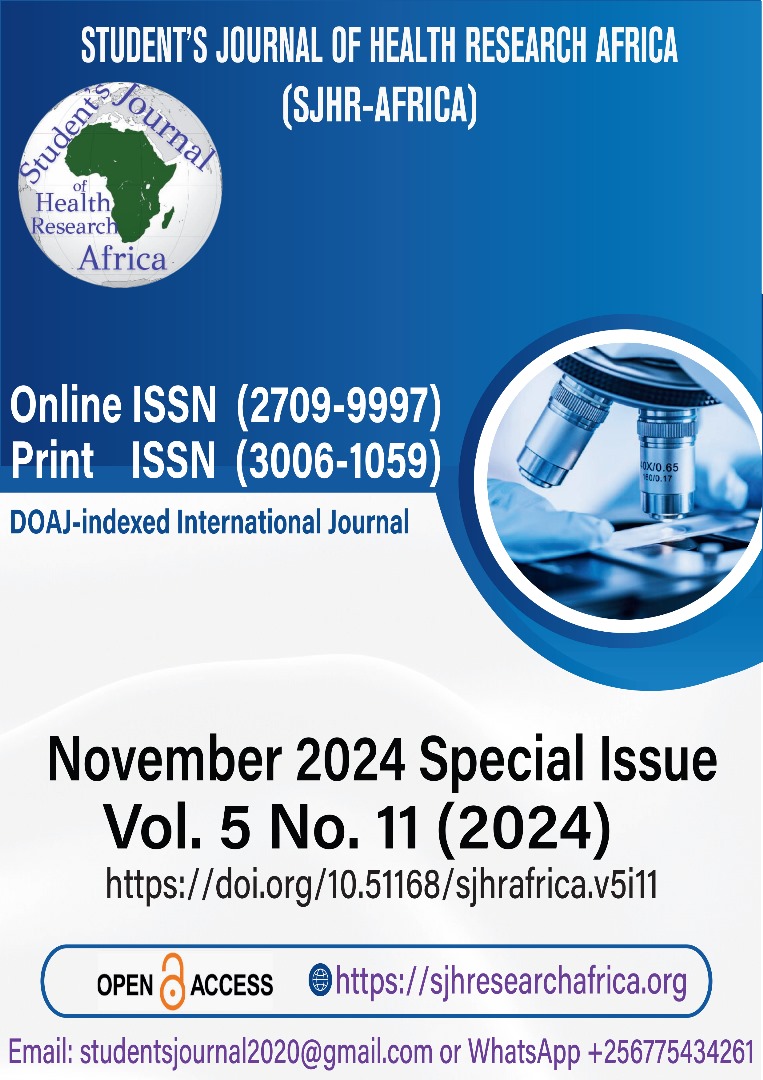CROSS SECTIONAL STUDY OF DEPRESSION, ANXIETY AND QUALITY OF LIFE IN GLAUCOMA PATIENTS AT A TERTIARY CARE CENTRE.
DOI:
https://doi.org/10.51168/sjhrafrica.v5i11.1804Keywords:
Glaucoma, depression, anxiety, quality of life, NEI VFQ-25, HADS, mental health, chronic ocular diseaseAbstract
Background
The chronic nature Glaucoma, along with the apprehension of blindness and ongoing treatment, may render patients susceptible to depression and anxiety, sometimes overlooked in therapeutic environments.
Objective
To investigate the prevalence and severity of depression and anxiety, as well as their impact on quality of life in patients diagnosed with glaucoma at a tertiary care centre.
Methods
This cross-sectional observational study was performed for a duration of 12 months at Jawahar Lal Nehru Medical College and Hospital, Bhagalpur. One hundred ten patients diagnosed with primary open-angle or angle-closure glaucoma were enrolled following informed consent. Standardized tools, such as the Hospital Anxiety and Depression Scale (HADS) and the National Eye Institute Visual Function Questionnaire-25 (NEI VFQ-25), were utilized to assess psychological condition and vision-related quality of life (QoL). Demographic and clinical characteristics, including age, gender, glaucoma type and duration, visual acuity, and intraocular pressure, were documented.
Results
Among the 110 participants, 42.7% displayed signs of depression, while 38.1% experienced clinically significant anxiety. Depression was more common in patients with advanced-stage glaucoma and bilateral visual field impairment. The NEI VFQ-25 scores were markedly diminished in individuals exhibiting elevated HADS scores, signifying a robust correlation between impaired visual function and compromised mental health and quality of life. Female patients and individuals with prolonged disease duration exhibited markedly elevated anxiety scores (p < 0.05).
Conclusion
Depression and anxiety are prevalent yet frequently disregarded comorbidities in glaucoma patients, significantly affecting their quality of life.
Recommendation
Routine psychological assessment and comprehensive mental health assistance should be incorporated into glaucoma therapy techniques, especially for patients with advanced illness, bilateral involvement, and unfavorable visual outcomes. A multidisciplinary strategy incorporating psychological counseling may enhance overall patient well-being and adherence to treatment.
References
George, R., Ve, R. S., & Vijaya, L. (2005). Glaucoma in India: estimated burden of disease. Journal of Glaucoma, 14(6), 507–513. https://doi.org/10.1097/01.ijg.0000186405.00403.aa
Gupta, V., Srinivasan, G., & Sharma, A. (2008). Patient awareness and attitudes toward glaucoma in an urban population in India. Ophthalmic Epidemiology, 15(4), 242–247. https://doi.org/10.1080/09286580802062162
Jampel, H. D., Friedman, D. S., Quigley, H., Vitale, S., & Miller, R. (2002). Correlation of the National Eye Institute Visual Function Questionnaire with vision and clinical findings in glaucoma patients. Archives of Ophthalmology, 120(6), 743–750. https://doi.org/10.1001/archopht.120.6.743
Mabuchi, F., Yoshimura, K., Kashiwagi, K., Shioe, K., Kanba, S., & Iijima, H. (2008). High prevalence of depression and sleep disorders in patients with normal tension glaucoma. Japanese Journal of Ophthalmology, 52(4), 302–308. https://doi.org/10.1007/s10384-008-0558-3
Mangione, C. M., Lee, P. P., Pitts, J., Gutierrez, P., Berry, S., & Hays, R. D. (2001). Psychometric properties of the National Eye Institute Visual Function Questionnaire (NEI-VFQ). Archives of Ophthalmology, 119(7), 1050–1058. https://doi.org/10.1001/archopht.119.7.1050
McKean-Cowdin, R., Wang, Y., Wu, J., Azen, S. P., & Varma, R. (2010). Impact of visual field loss on health-related quality of life in glaucoma: The Los Angeles Latino Eye Study. Ophthalmology, 115(6), 941–948. https://doi.org/10.1016/j.ophtha.2007.08.037
Quigley, H. A., & Broman, A. T. (2006). The number of people with glaucoma worldwide in 2010 and 2020. British Journal of Ophthalmology, 90(3), 262–267. https://doi.org/10.1136/bjo.2005.081224
Ramulu, P. Y. (2009). Glaucoma and disability: Which tasks are affected, and at what stage of disease? Current Opinion in Ophthalmology, 20(2), 92–98. https://doi.org/10.1097/ICU.0b013e32832401a9
Skalicky, S., Goldberg, I., & McCluskey, P. (2012). Depression and quality of life in patients with glaucoma: a cross-sectional analysis using the Geriatric Depression Scale-15, assessment of function related to vision, and the National Eye Institute Visual Function Questionnaire-25. Clinical & Experimental Ophthalmology, 40(7), 683–690. https://doi.org/10.1111/j.1442-9071.2012.02793.x
Sleath, B., Robin, A. L., Covert, D., Byrd, J. E., & Tudor, G. (2014). Patient-reported behavior and problems in using glaucoma medications. Ophthalmology, 113(3), 431–436. https://doi.org/10.1016/j.ophtha.2005.11.002
Taylor, S. A., Galbraith, S. M., Mills, R. A., & Drummond, S. R. (2016). Factors affecting adherence to glaucoma medical therapy in the elderly: a systematic review. British Journal of Ophthalmology, 100(2), 193–199. https://doi.org/10.1136/bjophthalmol-2015-306868
Tham, Y. C., Li, X., Wong, T. Y., Quigley, H. A., Aung, T., & Cheng, C. Y. (2014). Global prevalence of glaucoma and projections of glaucoma burden through 2040: a systematic review and meta-analysis. Ophthalmology, 121(11), 2081–2090. https://doi.org/10.1016/j.ophtha.2014.05.013
Wilson, M. R., Coleman, A. L., Yu, F., & Sasaki, I. (2002). Depression in patients with glaucoma as measured by self-report surveys. Ophthalmology, 109(5), 1018–1022. https://doi.org/10.1016/S0161-6420(02)00999-2
Zhang, X., Olson, D. J., Le, P., Lin, F. C., & Fleischman, D. (2015). The association between glaucoma, anxiety, and depression in a large population. American Journal of Ophthalmology, 159(3), 470–474.e2. https://doi.org/10.1016/j.ajo.2014.11.005
Downloads
Published
How to Cite
Issue
Section
License
Copyright (c) 2024 Govind Kumar Mandal, Pummy Roy, Jagdish Choudhary

This work is licensed under a Creative Commons Attribution-NonCommercial-NoDerivatives 4.0 International License.






















